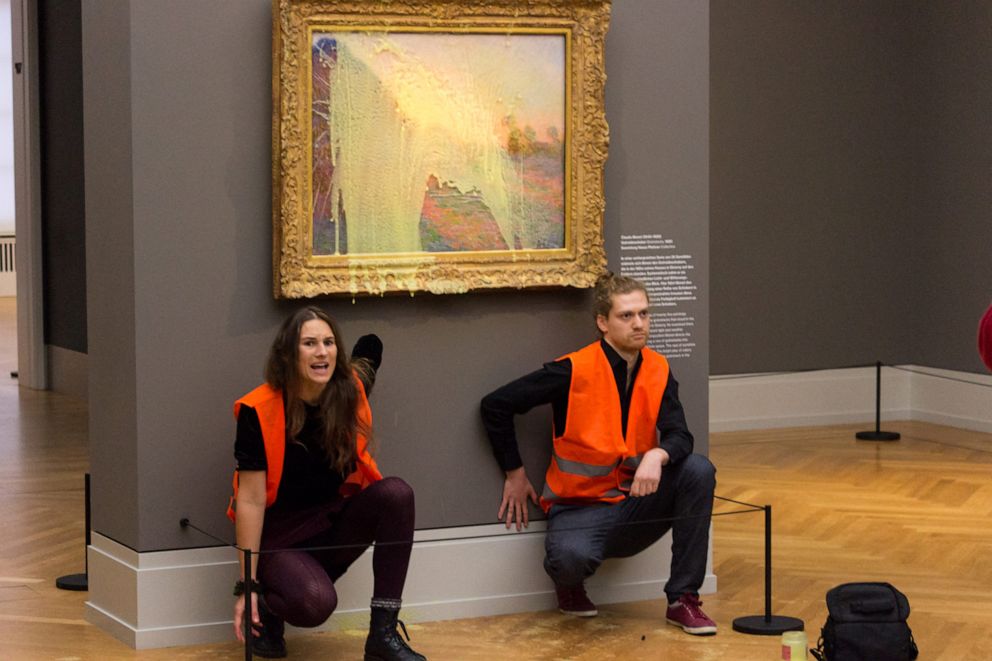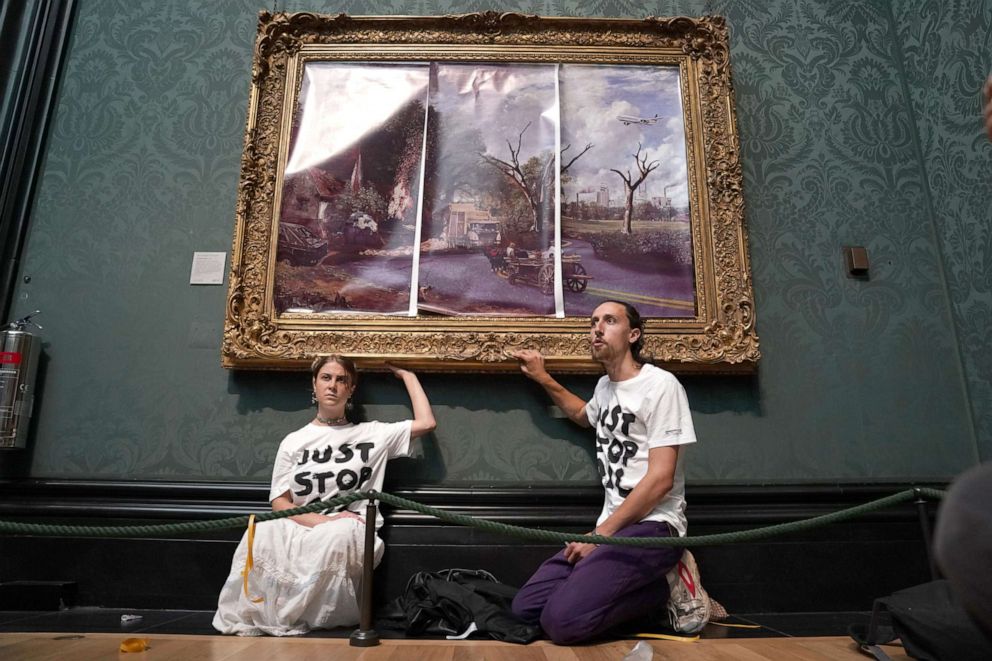Climate activists have been targeting priceless works of art all over the world to spread the urgent message of the global climate emergency — a move experts say is borne from desperation of what the planet will look like in the future.
The demonstrations began over the summer and have continued consistently through the start of the 2022 United Nations Climate Change Conference taking place in Sharm El-Sheikh, Egypt. On July 4, protesters glued their hands to John Constable’s “The Hay Wain” in London’s National Gallery.
Last month, tomato soup was thrown onto Van Gogh’s “Sunflowers” at the National Gallery in London, mashed potatoes were flung onto a Monet at the Museum Barberini in Potsdam, Germany and climate activists glued their hands to the famous “Girl with a Pearl Earring” painting at the Mauritshuis museum in The Netherlands.

Demonstrators participate in a Kick Big Polluters Out protest the COP27 U.N. Climate Summit, Nov. 10, 2022, in Sharm el-Sheikh, Egypt.
Peter Dejong/AP
Most recently, activists glued themselves to two of Goya’s paintings — “The Clothed Maja and The Naked Maja” — at the Prado museum in Madrid on Nov. 5. They then painted “+1.5 C” on the wall between the two works, signifying the international climate goal to keep global temperatures below a 1.5-degree Celsius rise since the Industrial Revolution began.
But these tactics are part of a well-used playbook by demonstrators to garner attention to the causes they support, experts told ABC News. These activists may feel as if words have failed them and the movement thus far and want to intensify the way the message is conveyed, Renee Lertzman, psychologist and founder of climate activism platform Project InsideOut, told ABC News.
“Confrontational activism has been part of kind of the suite of tactics that have been used around the climate issue for over 20 years now,” Dana R. Fisher, a professor of sociology at the University of Maryland who has been studying climate activism since the 1990s.
Climate activists, many of whom are young are worried about the life they and their children face in the future, are turning to more confrontational tactics for a reason, Fisher said. They are frustrated. They don’t believe the plans the governments of the world have in place for emissions mitigations are working. They don’t believe developing countries are receiving the financial and logistical support from the rich countries that spurred the climate crisis needed to rein in their own emissions. And they don’t believe governments are addressing the issues of environmental inequality and how impoverished, marginalized communities will be bearing the brunt of the events of a warming world, Fisher said.
The nature of climate protests is escalating as global temperatures fast approach tipping points, and these so-called attacks on art are a metaphor for what the activists believe is happening to the planet, Lise Van Susteren, a general and forensic psychiatrist who has researched how climate change has affected the psychological health of young people, told ABC News.
“They see with their own eyes what is happening to the planet, and that is, that we are destroying something that is priceless, and it can’t be repaired,” Van Susteren said.

People part of the ‘Pacific Island Students Fighting Climate Change’ (PISFCC) organization stage a protest, during the COP27 U.N. Climate Summit, in Sharm el-Sheikh, Egypt, Nov. 10, 2022.
Nariman El-mofty/AP
These acts of eco-vandalism, which are specifically targeting paintings covered in glass, as to not permanently destroy them, are not targeting climate deniers or people who refuse to listen to the science, the experts say. Rather, they are expressing their eco-distress and calling on those who sympathize with the movement as a call-to-action to pay more attention and put more effort into the fight against global warming, Van Susteren said.
Those who think climate change is a hoax will not change their perspective because someone threw soup or mashed potatoes on a painting, she added.
But what is necessary is for people to take a step back and ask what is driving young activists and fueling them to demonstrate in this way and reimagine solutions to get the world on track to mitigating greenhouse gas emissions, Lertzman said.
“We’re not gonna get out of this frankly by just addressing it from a technical perspective.” she added.

This handout picture released, Oct. 23, 2022, by “Last Generation” shows activists of the group being glued underneath the painting “Les Meules” by French artist Claude Monet after pouring mashed potatoes on the artwork in the Barberini Museum in Potsdam, Germany.
LAST GENERATION/AFP via Getty Images
To look at the effectiveness of targeting important works of art, it is important to weigh the cost and benefit of the action, Van Susteren said.
“And so while we may not easily condone something like this, in this particular case, the reality is that the cost isn’t so great, because the paintings aren’t being damaged,” she said.
The benefit, however, is measurable — especially considering the amount of media attention they garner afterwards, Van Susteren said.
“I think the fact that we are actually talking about this is evidence enough that it is doing something,” Lertzman said.

Protesters from Just Stop Oil climate protest group, glue their hands to the frame of John Constable’s The Hay Wain after first having covered the painting with their own picture inside the National Gallery, London, July 4, 2022.
PA Images via Getty Images
The demonstrations are a far cry from other tactics, such as blocking traffic or chaining oneself to the fence of the White House — both incidents that carry the possibility of an aggressive law enforcement response, Fisher said.
The activists engaging in these acts are “very attuned to the consequences” and repercussions, Van Susteren said. Vandalism is a legal issue, while climate action is a moral one — and the two are intersecting, she added.
But the seriousness of the crime has been emphasized in Italy, where four members of the Ultima Generazione — which translates to “Last Generation” — a climate campaign that runs on “disobedience,” are now facing up to five years in prison and fines between 2,500 and 15,000 euros for hurling pea soup at Van Gogh’s “The Sower” at the Palazzo Bonaparte on Nov. 4, Wanted in Rome, a magazine for English patriates that reports Roman news stories, reported.
Italy’s prime minister, Giorgia Meloni, condemned the act of demonstration, describing it as “vandalism, pure and simple,” according to the magazine.
“Ours is not vandalism, but the cry of alarm of desperate citizens,” Ultima Generazione said in response to Meloni’s statement.
Museums are also decrying the demonstrations. The Association of Art Museum Directors, a prominent museum group that includes many of the most important art institutions in the U.S. and Canada, said in a statement earlier this month that these acts “cannot be justified,” no matter what the motivations are.
“Art crosses boundaries of time and place to underscore the creativity that people everywhere have expressed, and they represent our shared humanity,” the statement read. “Attacking art for any purpose undermines those common bonds. Such protests are misdirected, and the ends do not justify the means.”
On Thursday, directors from 92 institutions all over the world, including the Musée du Louvre in Paris and the Museum of Modern Art in New York, released a signed statement warning that activists “severely underestimate the fragility” of the works of art they are targeting.
The art directors are “deeply shaken” by the recent attacks, according to the statement, issued by the National Committee in Germany of the International Council of Museums.
Fisher does not expect using eco-vandalism to demonstrate against climate change to go away any time soon, she said, adding that there are entire groups of “disruptors” or “confrontational activists” that train to protest in this very manner.
“To make social change, we actually need to see a full range of tactics being employed by activists to get us where we need to go. And so I think that the disruptors play an important role,” she said. “I think that we’ll see it become more frequent and more visible.”




